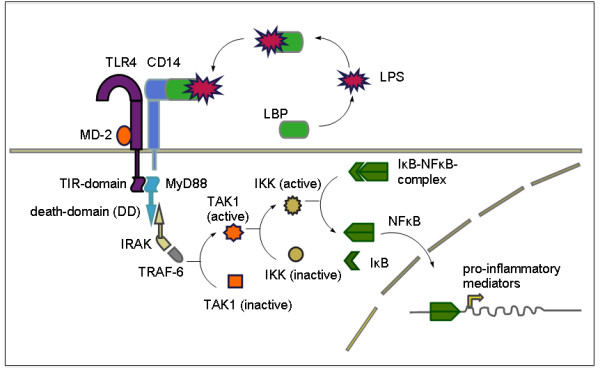As a leading CRO of antibody generation and development, Creative Biolabs offers application-specific antibody development services to global clients. With experienced scientists and advanced technology, we have established a series of high-quality in vitro diagnostic (IVD) antibody development services against biomarkers of different diseases. Here, we introduce our IVD antibody development services for lipopolysaccharide binding protein (LBP) marker.
General Introduction of LBP
LBP is a soluble 60-kDa glycoprotein that recognizes and binds the lipid A moiety of LPS, enhancing host immune response to endotoxin. The circulating LBP can bind to LPS in the blood or extracellular fluid forming a complex that facilitates LPS binding to CD14. LBP functions as a transport protein that disaggregates soluble LPS and presents it to targets on cellular membranes. Besides, it is a secretory acute-phase protein primarily synthesized in liver hepatocytes in response to bacterial infection and belongs to the lipid transfer/LBP family of proteins that includes bactericidal/permeability-increasing protein (BPI) and phospholipid transfer protein (PLTP). The crystal structure of LBP has not been determined, but the structure of the closely related BPI suggests that hydrophobic pockets on opposite sides of the boomerang-shaped structure may be responsible for binding the acyl chains of ligands such as LPS. LBP is not only important for early detection of serum LPS during bacterial infection, but production of high serum levels of LBP during infection and sepsis helps sequester LPS in order to dampen the detrimental inflammatory effects that manifest in this systemic disease. LBP reduces the risk of septic shock by extracting LPS from bacterial membranes or membrane blebs and transferring it directly to plasma lipoproteins such as high-density lipoprotein (HDL).
 Fig.1 Molecular model of α 1-acid glycoprotein. (Aghdassi, 2011)
Fig.1 Molecular model of α 1-acid glycoprotein. (Aghdassi, 2011)
The Role of LBP in Sepsis
Sepsis is a form of systemic inflammatory response syndrome (SIRS) caused by an overwhelming reaction to infection, usually by bacteria. It has been reported that the increased susceptibility of a newborn for septic infections is associated with the developmental deficiencies of the host defense system including a reduced ability of neonatal cells to produce cytokines like tumor necrosis factor alpha (TNF-α), interleukin-1β (IL-1β), IL-6, IL-8, and IL-12. LBP is the major plasma protein that contributes to transport endotoxin to immune effector cells bearing CD14 on their cell surfaces. It has been revealed that LBP can bind to the lipopolysaccharide of bacteria to form a complex that interacts with the macrophage receptor and initiates the pro-inflammatory host response. Hence, LBP is involved in the progression of human sepsis.
IVD Antibody Development Services for LBP Marker
In order to render more precise antibody-based diagnostic tools and assist clinicians in the diagnosis, prognosis, and staging of different diseases and infections, Creative Biolabs provides customized IVD antibody development services to generate high-quality antibodies for diagnostic usage. Besides antibody generation, we also offer antibody conjugation, antibody pairing, and diagnostic immunoassay development services to our clients.
For more detailed information, please feel free to contact us or directly send us an inquiry.
Reference
- Aghdassi A A, (2011). “Animal models for investigating chronic pancreatitis.” Fibrogenesis & Tissue Repair, 2011, 4(1), 26.
For Research Use Only.

